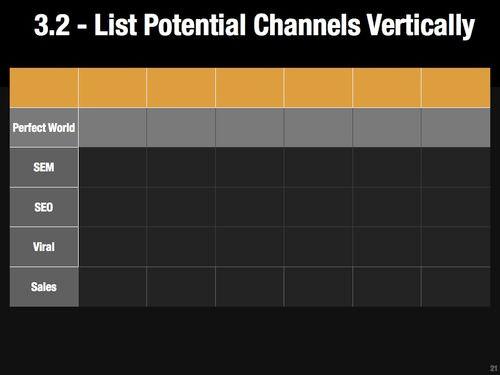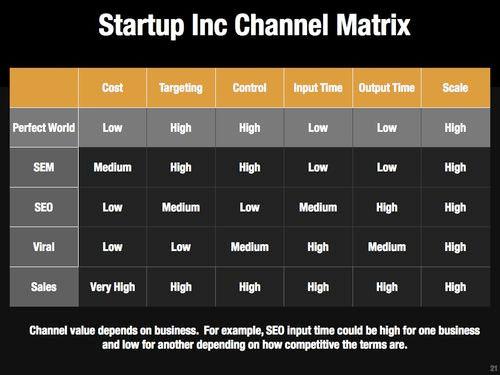Explore the World's Best Ideas
Join today and uncover 100+ curated journeys from 50+ topics. Unlock access to our mobile app with extensive features.
Step 1: What Are You Optimizing For?
Different times call for optimizing different things.
Learning - You might be trying to learn something specific about engagement, interest among a certain target audience, monetization, etc. Learning is typically the priority when your startup is a pre-product-market fit or when you are expanding to a new target audience.
Volume - There will be a time in your business when you will want to prove that you can go from a certain base amount of customers to moving the needle in a meaningful way.
Cost - Optimizing your CPA to get more out of your budget.
5
57 reads
Step 2: What are your constraints?
Your constraints will differ depending on the product, stage, funding, industry, etc. The most common constraints will be:
- Time - Do you have a specific optimal window to reach your audience? Do you only have 3 months of cash left?
- Money - Are you well funded, or bootstrapping? Do you need to extend your runway?
- Target Audience - Do you need to reach someone really specific?
- Legal - Are you taking on an old industry with litigious stalwarts?
6
25 reads
Step 3: Setup Your Channel Matrix
Building a channel matrix helps give you three things:
1. A methodical process to evaluate each channel
2. A way to compare each channel on the same attributes
3. A visual organization of the information for each channel
Step 3.1 - Open your favourite spreadsheet tool (google docs, excel, numbers)
Step 3.2 - List Out All Potential Channels In The Header Column
Certain channels can be broken down into more detailed tactics. For example, content marketing could be broken down into blogging, guest blogging, infographics, webinars, ebook, etc
5
21 reads
3.3 List Out Channel Defining Attributes In The Header Row
In the header row fill in the attributes of each channel that you are comparing. At a minimum, there are 6 attributes you should have:
- Targeting - The depth of ability to target different audiences.
- Cost - The upfront and ongoing cost to acquire users in this channel.
- Input Time - The upfront time required to start running experiments with this channel.
- Output Time - The time it takes to start getting data around your experiments.
- Control - The control you have over turning the channel on/off at will.
- Scale - The size/reach of the channel.
5
17 reads
Step 4: Fill In Values Of Channel Matrix With Low, Med, High
The next step is to research each channel so you can fill in each cell with “low”, “med”, or “high” values. You aren’t trying to predict exact values. Get enough information to make educated comparisons of each channel relative to each other.
The matrix looks very different for different companies. For example, “Low” will mean different things to different companies (i.e. A enterprise SaaS company with a high LTV vs a consumer mobile app monetizing with ads).
5
17 reads
Explore the value for each channel
Targeting: Does the channel have the type of targeting you need? How close to your exact target audience can you get with this channel?
Cost: Are there upfront costs? Minimum spends?
Input Time: How much time is required to get to the first experiment? How much time to run each additional experiment?
Output Time: How much time will it take to start getting results? How many experiments do we have to run to get meaningful data?
Control: Can you turn the channel on and off at will? Is there a middleman between you and the knobs you turn?
Scale: How large is the channel in overall volume?
5
9 reads
Step 5: Choose 1 - 2 Channels As Hypotheses
In a perfect world you want channels with the following values:
Targeting - High, Cost - Low, Input Time - Low, Output Time - Low, Control - High, Scale - High
You will rarely get a channel that fits those values perfectly so the question is how do you prioritize? This is where the work you put into Step 1 and Step 2 come in. Sort your channels using your constraints as a guide. If your biggest constraint is money, then look at channels that have a low cost as the first priority and come closest to the ideal values for the other attributes.
5
9 reads
IDEAS CURATED BY
Generalist. Great minds discuss ideas, average minds discuss events, small minds discuss people.
Yug Jain's ideas are part of this journey:
Learn more about marketingandsales with this collection
How to beat procrastination
How to enhance your creative thinking
How to create a smooth transition in a new endeavor
Related collections
Similar ideas
Read & Learn
20x Faster
without
deepstash
with
deepstash
with
deepstash
Personalized microlearning
—
100+ Learning Journeys
—
Access to 200,000+ ideas
—
Access to the mobile app
—
Unlimited idea saving
—
—
Unlimited history
—
—
Unlimited listening to ideas
—
—
Downloading & offline access
—
—
Supercharge your mind with one idea per day
Enter your email and spend 1 minute every day to learn something new.
I agree to receive email updates



